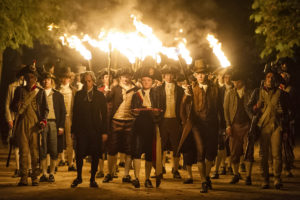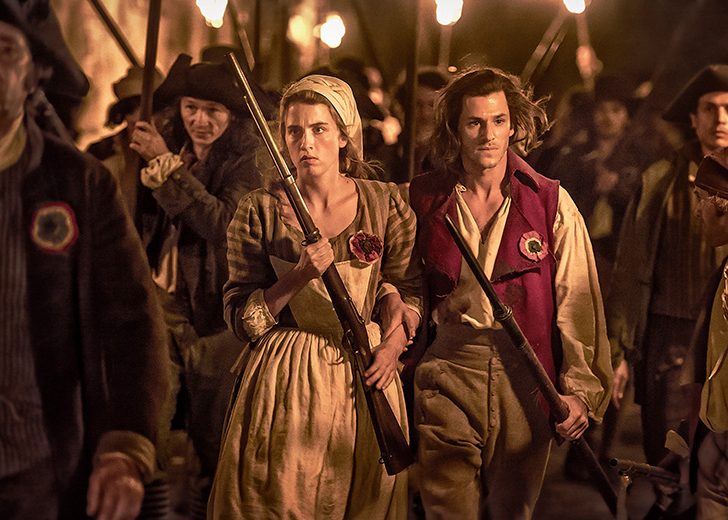One Nation, One King
Fragments of a revolution
 One of the most well-known events in Universal History in the world is the French Revolution. Paradoxically, it is also poorly understood by most people. Many people think that there was an invasion of the symbolic prison of the Bastille on July 14, 1989, and everything was solved! In fact there have been decades of much confusion in the country, until the establishment of France as it is today. One of the many films that shed some light on the facts is the recent “One Natio, One King” (“Un peuple et son roi”, FRA, 2018), written and directed by Pierre Schoeller.
One of the most well-known events in Universal History in the world is the French Revolution. Paradoxically, it is also poorly understood by most people. Many people think that there was an invasion of the symbolic prison of the Bastille on July 14, 1989, and everything was solved! In fact there have been decades of much confusion in the country, until the establishment of France as it is today. One of the many films that shed some light on the facts is the recent “One Natio, One King” (“Un peuple et son roi”, FRA, 2018), written and directed by Pierre Schoeller.
It is very difficult for most people to understand the magnitude of what the French Revolution was, and its effects around the world. At that time, with rare exceptions, the world was divided between absolutist monarchies and their colonies. Cases like the parliamentary monarchy of Great Britain and the American republic were rarities.
Although there were already currents that defended the deposition of the French king, this hypothesis did not represent the desire of the majority, since the monarchy was an institution that existed for centuries, based on the theory of a power granted by God, and with a symbiotic relationship with the powerful Catholic church.
 Thus, in the first days of the Revolution, the National Assembly was formed, constituted by the powerful ones of the time, but under strong pressure of the population. It is curious that the surprising Declaration of Human Rights, which ensured that all men were equal, had to be endorsed by King Louis XVI, the representative of a nobility who denied this possibility!
Thus, in the first days of the Revolution, the National Assembly was formed, constituted by the powerful ones of the time, but under strong pressure of the population. It is curious that the surprising Declaration of Human Rights, which ensured that all men were equal, had to be endorsed by King Louis XVI, the representative of a nobility who denied this possibility!
While the National Assembly was trying to reduce the impacts of the new regime, and even some argued that the revolution needed to be stopped, others inflamed the process with speeches and newspaper articles calling for an end to the privileges of the nobility and improvement of the people’s conditions. And before anyone who is unaware imagines it would be a communist revolt, it is worth remembering that Karl Marx was only to be born in 1818, and his famous Communist Manifesto would only be published in 1848.
 Often we make the mistake of analyzing a historical fact with the current perspective. At the time of the French Revolution, communications were confined to newspapers and }word-of-mouth, so we can imagine that disinformation in those confused times was an extremely disruptive factor, coupled with so many other interests.
Often we make the mistake of analyzing a historical fact with the current perspective. At the time of the French Revolution, communications were confined to newspapers and }word-of-mouth, so we can imagine that disinformation in those confused times was an extremely disruptive factor, coupled with so many other interests.
“One Nation, One King” features famous historical figures such as Robespierre, Marat, Danton and others defending their ideas in the Assembly, while the people of Paris, closer to the events, participated in the galleries, mainly discussing the facts and trends that arose throughout time.
 There is no doubt that for many deputies and even for the population, the king was a figure of extreme symbolism, so much that the biggest debate was between keeping him as head of state or executing it. The event that triggered the most extreme reaction was the attempted escape of the royal family.
There is no doubt that for many deputies and even for the population, the king was a figure of extreme symbolism, so much that the biggest debate was between keeping him as head of state or executing it. The event that triggered the most extreme reaction was the attempted escape of the royal family.
With the popular movement of 1789, the king was obliged to leave the palace of Versailles and settle in the palace of the Tuileries, in the center of Paris. He had also been forced to accept articles of the new Constitution that greatly limited his powers. In a daring action, with the help of a few friends, he and the royal family tried to escape to Montmédy, on the eastern border of the country, where there were loyal monarchist forces, but was recognized in Varennes, where he was obliged to return to Paris.
 From then on, the pressure for the king’s fall became stronger and stronger, for if he had succeeded in escaping he could receive help from other sovereigns – his wife, Marie Antoinette, was Austrian. In addition, the French movement posed a threat to all European monarchies. No wonder the act was considered a betrayal, and contributed to the end of the king’s prestige.
From then on, the pressure for the king’s fall became stronger and stronger, for if he had succeeded in escaping he could receive help from other sovereigns – his wife, Marie Antoinette, was Austrian. In addition, the French movement posed a threat to all European monarchies. No wonder the act was considered a betrayal, and contributed to the end of the king’s prestige.
The film shows the historic trial by the National Assembly, without witnesses and with evidence now considered dubious, where the king was accused of countless crimes. 370 deputies voted for his execution while 319 voted for forced exile. Thus, King Louis XVI was beheaded in a public square on January 21, 1793.
 “One Nation, One King” shows a limited view of the French Revolution, but no less valid. As I said above, this French historical period, which reverberated throughout the world, would still have its effects lasting for decades, especially in the Reign of Terror, a period in which Robespierre and the Jacobins were in power, where an estimated 16 to 40 thousand people were executed for conspiring against the state.
“One Nation, One King” shows a limited view of the French Revolution, but no less valid. As I said above, this French historical period, which reverberated throughout the world, would still have its effects lasting for decades, especially in the Reign of Terror, a period in which Robespierre and the Jacobins were in power, where an estimated 16 to 40 thousand people were executed for conspiring against the state.
Other movies help to better understand this period and some of the events cited, such as “Danton” (“Danton”, FRA, 1983), “The Night of Varennes” (“La nuit de Varennes”, FRA 1982), “Marie Antoinette” (“Marie Antoinette”, USA, 2006), “Napoleon” (“Napoléon vu par Abel Gance”, FRA, 1927), “The French Revolution” (“La révolution française”, FRA, 1989), “La Marseillaise” (“La Marseillaise” FRA, 1938), and also the various versions of “Les Miserables”.
 The French Revolution is a very interesting subject, not only by the historical events themselves, but also by the influence they had in the world, inspiring movements of independence and understanding of the role of Man. Any time we devote to knowing the subject better will surely make us richer in knowledge and culture. The movie “One Nation, One King” is part of the selection of the Varilux French Film Festival 2019, which happens at the moment in several capitals of Brazil. Enjoy it.
The French Revolution is a very interesting subject, not only by the historical events themselves, but also by the influence they had in the world, inspiring movements of independence and understanding of the role of Man. Any time we devote to knowing the subject better will surely make us richer in knowledge and culture. The movie “One Nation, One King” is part of the selection of the Varilux French Film Festival 2019, which happens at the moment in several capitals of Brazil. Enjoy it.






